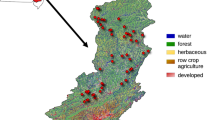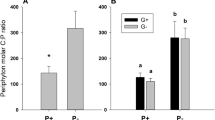Abstract
To establish a general model for the removal rate of periphyton by grazers, we identified 27 publications in which removal rates could be estimated from grazer enclosure or exclosure experiments. When all the measurements obtained under different experimental conditions were extracted, these publications provided 107 data points. Multiple regression of these data showed that periphyton removal rate increased significantly with grazer body mass and food availability, and decreased with grazer crowding. Grazer body mass explained 65% of the variation, while crowding and food availability explained 7 and 6% respectively. Except for the significantly lower removal rate of amphibians, neither taxon of the grazer nor algal composition significantly affected removal rate. Experiments in the laboratory and in outdoor channels tended to give higher removal rates than experiments performed in streams or lakes. A comparison with previous allometric equations predicting the ingestion rate of other invertebrate guilds, and with experiments in which periphyton ingestion rate was measured as incorporation of labelled food, indicated that a large portion of periphyton is removed by the activity of the grazer rather than by direct ingestion. These results could be utilized to predict the impact of grazing on periphyton biomass.
Similar content being viewed by others
References
Bowen SH (1979) Determinants of the chemical compositionof periphytic detrital aggregate in a tropical lake (Lake Valensia, Venezuela). Arch Hydrobiol 87:166–177
Calow P, Fletcher CR (1972) A new radiotracer technique involving 14C and 51Cr for estimating the assimilation efficiencies of aquatic primary consumers. Oecologia 9:155–170
Cammen LM (1980) Ingestion rate: an empirical model for aquatic deposit feeders and detritivores. Oecologia 44:303–310
Capblancq J, Cassan M (1979) Etude du périphyton d'une rivière polluée (L'Agout). I. Structure et développement des communautés sur substrats artificiels. Ann Limnol 15:193–210
Capriulo GM, Lints D, Lewinter M (1990) Ingestion rate and body size in phagotrophic organisms. Can J Zool 68:313–317
Castenholz RW (1961) The effect of grazing on marine littoral diatom populations. Ecology 42:783–794
Cattaneo A (1983) Grazing on epiphytes. Limnol Oceanogr 28:124–132
Cuker BE (1983) Grazing and nutrient interactions in controlling the activity and composition of the epilithic algal community of an Arctic lake. Limnol Oceanogr 28:133–141
Cummins KW, Wuycheck JC (1971) Caloric equivalents for investigations in ecological energetics. Int Ver Theor Angew Limnol Mit 18:1–158
Cyr H, Pace ML (1993) Allometric theory: extrapolations from individual to communities. Ecology 74:1234–1245
Dickman M (1968) The effect of grazing by tadpoles on the structure of a periphyton community. Ecology 49:1188–1190
Doremus CM, Harman WN (1977) The effects of grazing by Physid and Planorbid freshwater snails on periphyton. Nautilus 91:92–96
Eckblad JW (1971) Weight-length regression models for three aquatic gastropod populations. Am Midl Nat 85:271–274
Eichenberger E, Schlatter A (1978) Effect of herbivorous insects on the production of benthic algae vegetation in outdoor channels. Verh Internat Verein Limnol. 20:1806–1810
Eloranta PV (1982) Periphyton growth and diatom community structure in a cooling water pond. Hydrobiologia 96:253–265
Eloranta P, Kunnas S (1979) The growth and species communities of the attached algae in a river system in Central Finland. Arch Hydrobiol 86:27–44
Feminella JW, Power MA, Resh VH (1989) Periphyton responses to invertebrate grazing and riparian canopy in three northern California coastal streams. Freshwater Biol 22:445–457
Gons HJ (1982) Structural and functional characteristics of epiphyton and epipelon in relation to their distribution in Lake Vechten. Hydrobiologia 95:79–114
Gresens SE, Lowe RL (1994) Periphyton patch preference in grazing chironomid larvae. JN Am Benthol Soc 13:89–99
Hart DD (1987) Experimental studies of exploitative competition in a grazing stream insect. Oecologia 73:41–47
Hill WR, Knight AW (1987) Experimental analysis of the grazing interaction between a mayfly and stream algae. Ecology 68:1955–1965
Hill WR, Knight AW (1988) Concurrent grazing effect of two stream insects on periphyton. Limnol Oceanogr 33:15–26
Hill WR, Boston HL, Steinman AD (1992) Grazers and nutrients simultaneously limit lotic primary productivity. Can J Fish Aquat Sci 49:504–512
Hunter RD (1980) Effects of grazing on the quantity and quality of freshwater Aufwuchs. Hydrobiologia 69:251–259
Jacoby JM (1985) Grazing effects on periphyton by Theodoxus fluviatilis (Gastropoda) in a lowland stream. J Freshwater Ecol 3:265–273
Jacoby JM (1987) Alterations in periphyton characteristics due to grazing in a Cascade foothill stream. Freshwater Biol 18:495–508
Kairesalo T, Koskimies I (1987) Grazing by oligochaetes and snails on epiphytes. Freshwater Biol 17:317–324
Kesler DH (1981a) Grazing rate determination of Corynoneura scutellata Winnertz (Chironomidae: Diptera). Hydrobiologia 80:63–66
Kesler DH (1981b) Periphyton grazing by Amnicola limosa: an enclosure-exclosure experiment. J Freshwater Ecol 1:51–59
Lakatos GY (1978) Comparative analysis of biotecton (periphyton) samples collected from natural substrate in waters of different trophic state. Acta Bot Acad Sci Hung 24:285–299
Lamberti GA (1993) Grazer-algal interactions. In: Lamberti GA, Steinman AD (eds) Research in artificial streams; applications, uses, and abuses. JN Am Benthol Soc 12:337–342
Lamberti GA, Feminella JW, Resh VH (1987a) Herbivory and intraspecific competition in a stream caddisfly population. Oecologia 73:75–81
Lamberti GA, Ashkenas LR, Gregory SV, Steinman AD (1987b) Effects of three herbivores on periphyton communities in laboratory streams. JN Am Benthol Soc 6:92–104
Lamberti GA, Gregory SV, Askhenas LR, Steinman AD, McIntire CD (1989) Productive capacity of periphyton as a determinant of plant-herbivore interactions in streams. Ecology 70:1840–1856
Lamberti GA, Gregory SV, Hawkins CP, Wildman RC, Askhenas LR, Denicola DM (1992) Plant-herbivore interactions in streams near Mount St Helens. Freshwater Biol 27:237–247
Malone CR, Nelson DJ (1970) Feeding rates of freshwater snails (Goniobasis clavaeformis) determined with Co60. Ecology 50:728–730
Mason CF, Bryant RJ (1975) Periphyton production and grazing by chironomids in Alderfen Broad, Norfolk. Freshwater Biol 5:271–277
McCullough DA, Minshall GW, Cushing CC (1979) Bioenergetics of stream “collector” organism Tricorythodes minutus (Insecta: Ephemeroptera). Limnol Oceanogr 24:45–58
McIntire CD, Phinney HK (1965) Laboratory studies of periphyton production and community metabolism in lotic environments. Ecol Monogr 35:237–258
Meyer E (1989) The relationship between body length parameters and dry mass in running water invertebrates. Arch Hydrobiol 117:191–203
Mulholland PJ, Steinman AD, Palumbo AV, DeAngelis DL, Flum TE (1991) Influence of nutrients and grazing on the response of stream periphyton communities to a scour disturbance. JN Am Benthol Soc 10:127–142
Murphy ML (1984) Primary production and grazing in freshwater and intertidal reaches of a coastal stream, southeast Alaska. Limnol Oceanogr 29:805–815
Peters RH, Downing JA (1984) Empirical analysis of zooplankton filtering and feeding rates. Limnol Oceanogr 29:763–784
Rounick JS, Winterbourn MJ (1983) The formation, structure and utilization of stone surface organic layers in two New Zealand streams. Freshwater Biol 13:57–72
Smock LA (1980) Relationships between body size and biomasses of aquatic insects. Freshwater Biol 10:375–383
Steinman AD (1991) Effects of herbiyore size and hunger level on periphyton communities. J Phycol 27:54–59
Steinman AD, McIntire CD, Gregory SV, Lamberti GA, Ashkenas LR (1987) Effects of herbivore type and density on taxonomic structure and physiognomy of algal assemblages in laboratory streams. JN Am Benthol Soc 6:175–188
Stewart JA (1987) Response of stream algae to grazing minnows and nutrients: a field test for interactions. Oecologia 72:1–7
Straškraba M (1980) The effects of physical variables on freshwater production; analysis based on model. In: Le Cren ED, Lowe-McConnell RH (eds) The functioning of freshwater ecosystems (IBP Handbook 22). Cambridge University Press, Cambridge, pp 13–85
Sumner WT, McIntire CD (1982) Grazer-periphyton interactions in laboratory streams. Arch Hydrobiol 93:135–157
Trama FB (1972) Transformation of energy by an aquatic herbivore (Stenonema pulchellum) Ephemeroptera. Pol Arch Hydrobiol 19:113–121
Tuchman NC, Stevenson RJ (1991) Effects of selective grazing by snails on benthic algal succession. JN Am Benthol Soc 10:430–443
Tukey JW (1977) Exploratory data analysis. Addison-Wesley, Reading, Massachussets
Author information
Authors and Affiliations
Additional information
A contribution of the “Groupe d'Écologie des eaux douces”, Université de Montréal
Rights and permissions
About this article
Cite this article
Cattaneo, A., Mousseau, B. Empirical analysis of the removal rate of periphyton by grazers. Oecologia 103, 249–254 (1995). https://doi.org/10.1007/BF00329087
Received:
Accepted:
Issue Date:
DOI: https://doi.org/10.1007/BF00329087




